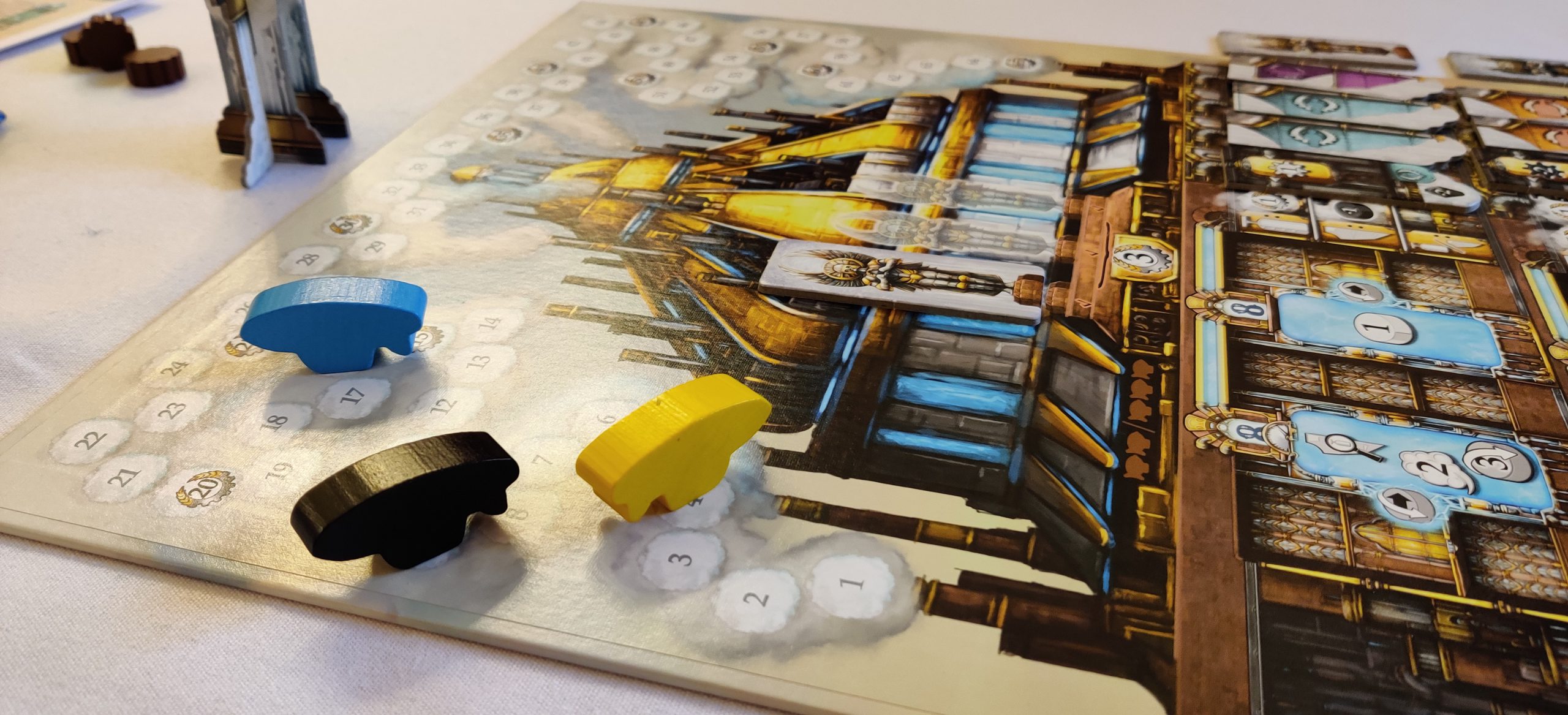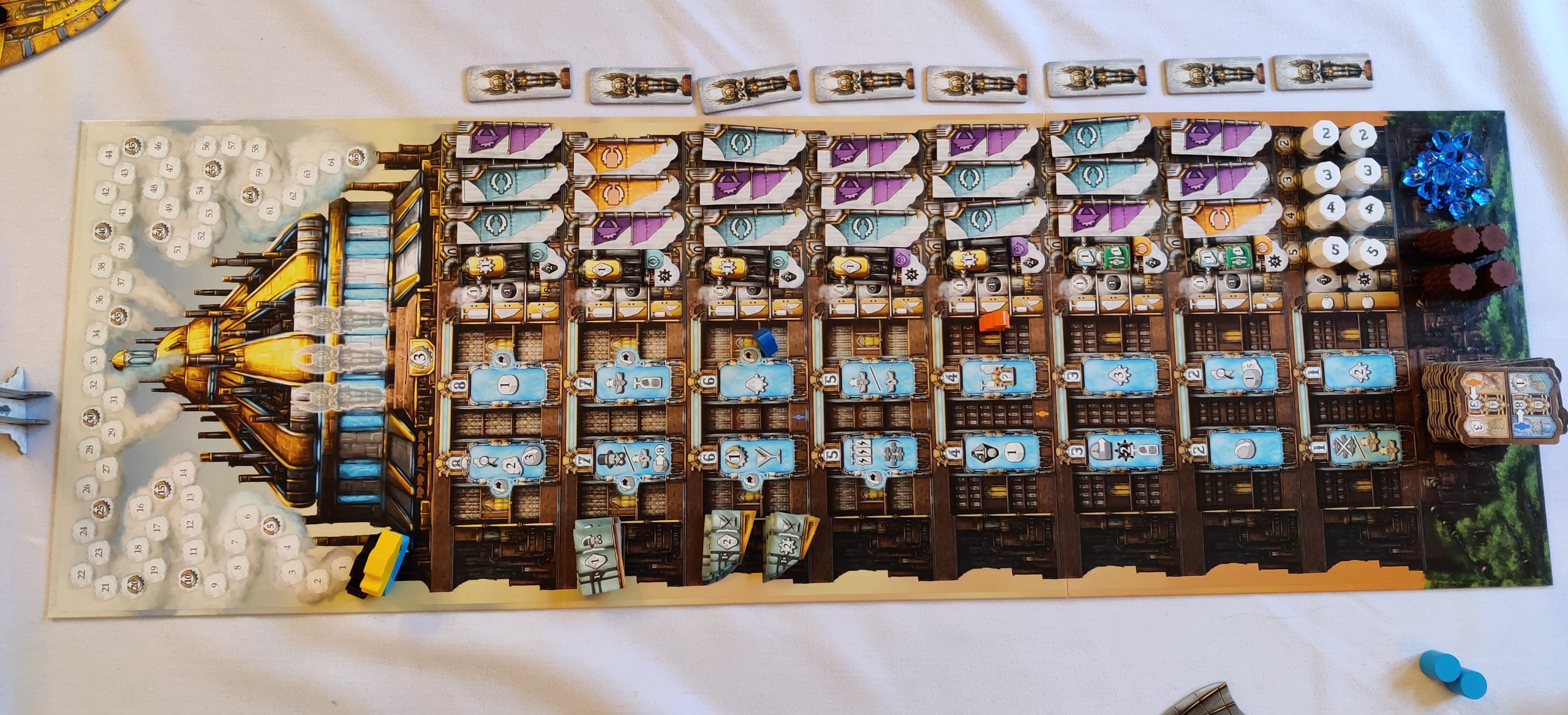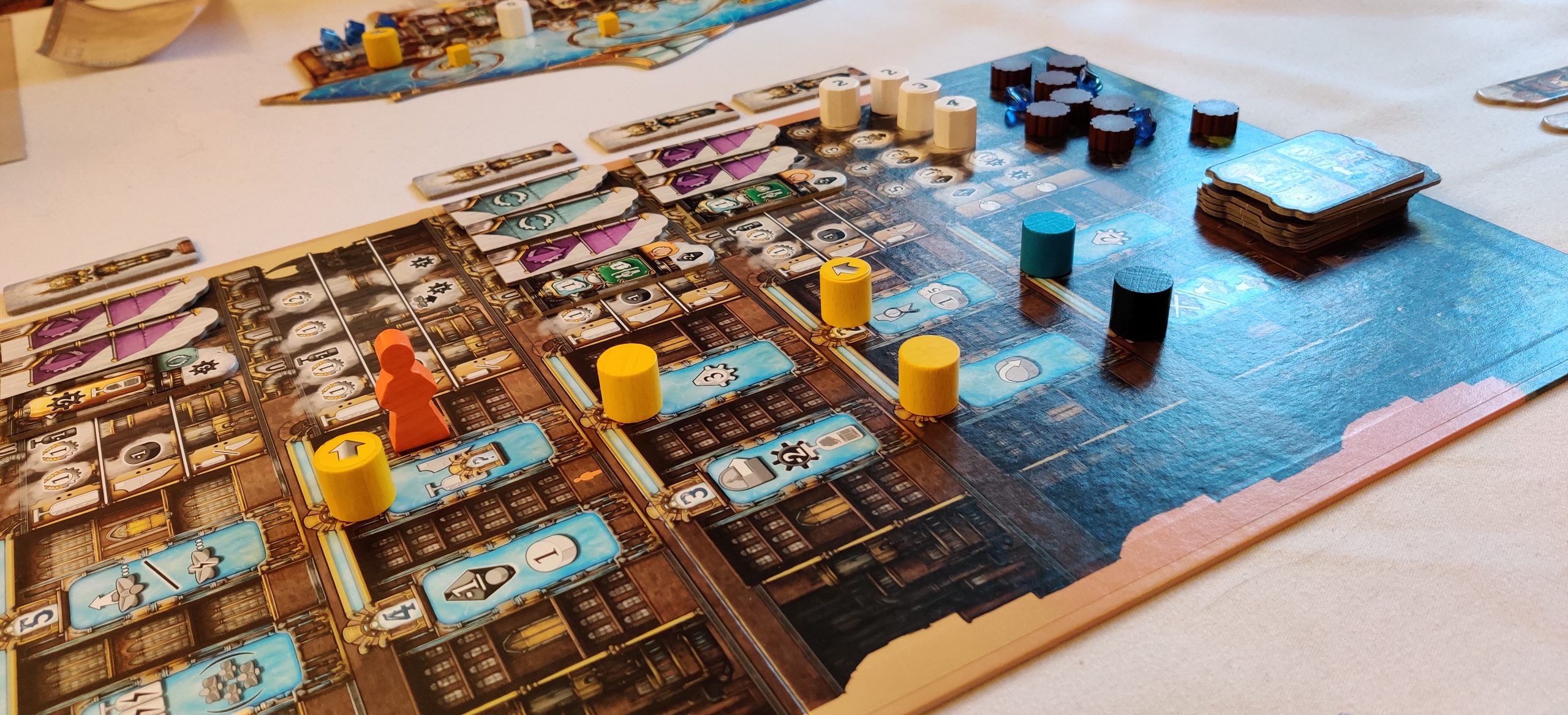Steamopolis — Prepare for a headache
How do you feel about headaches? Is there such a thing as a good headache? This question is fairly central to how someone is likely to feel about Steamopolis, from Corax Games and designed by Gerhard Hecht. Fundamentally, Steamopolis is possessed of the same dichotomy that is true of a lot of worker placement games (which this mostly is, more on that later): when you describe how to play it, it sounds like it should be pretty straightforward. The complexity of the game is not in the rules but in the choices; and there are a lot of choices.
Every player has a marvellous cardboard airship in front of them and, in turn, each player is clustered around a long, central board that represents the city of Steamopolis itself. On their turn a player will choose to do one of three, seemingly simple, actions.
Firstly, a player can increase the steam pressure on your airship. This is represented by round wooden tokens that sit on markers numbered from 1 to 8. These numbers represent the pressure of the steam in the ship, and the volume of tokens represents the amount of steam. Having more steam at higher pressures is good in the game because it both lets the player visit places in the city that are higher up (and more valuable) and because it lets them run steam through more machines. You see, underneath the steam track are a bunch of tokens that show the engine and machines on the ship; both in game and fluff terms. These machines can have a variety of effects when steam is pushed through them, from providing resources (the game has two; cogs and crystals) to sending spybots to other players’ airships to giving passive triggers that will provide rewards for completing certain actions with victory points.

The second action is to reserve a spot at a factory in the city. Steamopolis has eight floors that can be visited, each with two or three factories on them. These factories all have various different effects. To do this, the player takes a steam token from their airship, runs it through any machines they wish, and then places that token on an unoccupied slot at a factory on a floor of the city no higher than the remaining steam pressure the token has. It’s slightly disguised but this is, fundamentally, basic worker placement stuff. Steam tokens are workers and the factories are the action spaces. Like most worker placements, there can’t be more than one worker per space, so choosing when to release steam and where to visit is key to success.
The other nuance here is that use of the term “remaining steam pressure”. When you reserve a spot at a factory there is an important choice to make; how many machines to run? A steam token can be descended through the bowels of the ship to get the benefits or the triggers of any machines down there but, once the last one has been run, there is a little number by it that says what the steam pressure now is at that spot. Perhaps the token started at a pressure of eight, letting it be placed in any factory on any floor of the city, but by the time it’s been run through some machines it’s now only at four. The heights of the city are now closed, for this turn at least, and the token can only be placed at factories at floor four or lower. This concept may sound a little tricky to manage, and it is, but only in terms of the player having to choose how to balance their engine and the factories they visit. In terms of the visualization of this process on the game board, it couldn’t be better. Steamopolis, in general, does a tremendous job of making sure that everything a player can do, and the effect of any space on any board, is clear and transparent.

The final thing a player can do on their turn is to visit the city. When they reserve a spot at a factory in the second action, the player doesn’t actually go there and use the factory there and then. Again, this isn’t a concept unfamiliar to the world of worker placement games but it is very neatly implemented here and has just enough of a twist to keep it fresh. When a player visits the city they can go to any floor they have steam tokens on, in whatever order they wish. On that floor they can choose whether to activate the ability of the factory they are visiting or forgo that benefit to go to the market on that floor. These markets are all separate from each other and contain the machines that the player can fill their airship with for benefits when steam is passed through them. Adding yet another layer of choice to this is that any one of these machines can, instead, be purchased as a banner to fly from the back of an airship. These banners basically act as victory point multipliers but, not only do they have no other in-game or engine effect, they actually reduce the aerodynamics of your ship and, therefore, permanently remove a steam token from the airship they’re placed on.
There are also passengers in the city, represented by coloured meeples, complicating the decision about which floor to visit when. Each of these meeples sits on a floor and a card will tell every player what floor that passenger wants to visit. When a player visits a floor they can pick up a passenger or drop off a passenger, receiving a reward for the latter. The key thing is that passengers will not stay on airships between visits, they must be picked up and dropped-off in one “visit the city” action. The combination of all these factors means that the sequencing of which floors to visit, and in which order, is the second major headache of Steamopolis. Perhaps a player has to go to floor four and then floor two in order to pick up and drop off a passenger, but to activate the factory on floor four they need some resources from the factory on floor two. Situations like that can feel awful; very obvious occasions where a player knows they could have accomplished everything they wanted if they had planned better really hurt. This means that every time a player reserves a spot at a factory they have to have an eye on where they are going to go when they visit the city and in what order. Perhaps reserving a spot at a factory on floor six is only worth it if one specific spot on floor two can be reserved next turn. What happens if someone else takes that spot before then? What’s plan B? This is the core puzzle of Steamopolis and it is a delightful, but not easy, one.

That, in a nutshell, is Steamopolis. Every turn, each player is deciding whether to choose an action space to reserve, whether to activate all the action spaces they currently have reserved or just increase the options of where they can go by building steam pressure. This basic choice, and the decisions about maximising efficiency it entails, is the first, and most fundamental headache in the game. The dream, the absolute dream, is that your airship runs like a well-oiled machine. Steam pressure can be self-generating, through various means, hopefully allowing the player to get to high floors of the city (or run many machines) without having to take the action to build pressure. Once the initial turns of the game are passed, taking the action to increase pressure feels like a waste and something that should be eminently avoidable.
The choice about when to visit the city is no easier. Again, in an ideal world, the player would wait until all of their steam tokens are at factories in the city before visiting, getting to activate the most floors in the fewest actions. Life, though, is not that simple. Every turn you don’t visit the city is a turn when someone else can. Maybe they will take the machine from the market you wanted. Maybe they will deliver the passenger you wanted to and now they don’t want to go anywhere you’re going. Maybe they’ll take the last useful spot you could have visited and you’re left spending a turn putting a steam token somewhere that has very little use for you.
There is an element of a push-your-luck mechanic here that feels tense and appealing in the game and something, in general, that Steamopolis accomplishes is making every single turn both meaningful and relatively short. It really feels like having an inefficient turn can be a major setback whilst also not leaving anyone with much downtime between turns, keeping the game moving and the pace high. Which, in turn, adds more pressure onto decisions.

And so, we return to headaches. The other players who joined me for Steamopolis all agreed that this was a game firmly in the heavier end of board games we’d ever played. Not in time, it should be noted (we finished in less than three hours even with learning the game) but in the amount of focus and brain power it requires. There are no easy decisions and every choice a player makes either comes with the weight of knowing it is an inefficient move or with its own set of sub-choices that will affect the efficiency of future turns. Or both.
If this amount of choice and pressure sounds intriguing then Steamopolis is absolutely the game for you. The puzzle and the engine building is delightful, clear and extremely well-implemented. Add to this the fact that the game comes in an appealing package with high-quality art and components and what you have here is a centrepiece game with a huge amount of depth, a minimum of RNG and a great deal of satisfaction to be taken when maximum efficiency is achieved. It cannot be stressed enough though that this game is heavy. Likely you will come out of it feeling slightly brain-fried and if you (or your usual group) skews more to the mid-level or light end of the gaming spectrum then Steamopolis may just feel baffling.
Steamopolis is currently only available as a German language edition, although there are English language PDFs of all the game resources on Board Game Geek and Japanese language versions on Tendays Games. Corax Games have spoken of the possibility of kickstarting an English-language run via Academy Games (Fief, Stellaris Infinite Legacy) but it remains to be seen whether that will emerge. Regardless, any copy of the game you can get right now will be fine for anyone who speaks German, Japanese or English.
Love board games? Check out our list of the top board games we’ve reviewed.
Comments are closed.